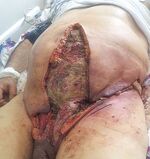Acute scrotum
Acute scrotum (acute scrotal syndrome, ASS) is an emergency condition that involves several units. Common symptoms are sudden swelling and pain in half or the entire scrotum. The anamnesis is usually shorter than 12 hours.
Diagnostics[edit | edit source]
During the examination, we focus on the three most common etiologies. First of all, we want to rule out (or confirm) testicular torsion.
We begin with an anamnesis , in which we are interested not only in the current state of the symptoms, but also in the time and circumstances of their occurrence, together with their subsequent development up to the present moment:
- localization and nature of pain, when and how quickly it started, its propagation;
- abdominal pain or groin pain;
- swelling (if present) preceded pain or vice versa;
- subfebrile or febrile;
- nausea and vomiting;
- dysuric problems;
- burning or cutting sensation, pruritus or dull pain when urinating;
- frequent urge to urinate;
- history of urinary tract infections;
- sexual history (sexually transmitted diseases);
- data about the event. genital trauma;
- information on prenatal ultrasound screening for congenital malformations;
- we will specifically ask about systemic diseases, specifically: hematomas, petechiae and B-symptoms.
We continue with a physical examination of the patient in a calm and quiet environment with good lighting, first in a standing position (aspect and examination of the cremasteric reflex) and then in a supine position with the lower limbs in the "Turkish sit".
- First we notice the position of the testes . Are they visible just by looking? Noticeably elevated position of one of them?
- We examine the cremasteric reflex by irritating the inner thighs with a not quite blunt object.
- If the testes are in the scrotum, we are interested in their orientation - is it vertical or horizontal?
- At first glance, is the scrotum swollen, red or bruised somewhere?
- We gradually palpate the testicles, epididymis and spermatic cord.
- We stretch the tamer's skin between the fingers and look for blue-dot signs .
- We do not forget to carefully drag the foreskin (only where it can be dragged freely) and visually inspect the mouth of the urethra.
- By feeling, we examine whether the groin is loose.
- We will perform a complete physical examination of the abdomen, including Israeli palpation and tapotement .
In case of neglect or ignorance of the issue, there is a risk of irreversible loss of the testicle.
Clinical units[edit | edit source]
Testicular torsion[edit | edit source]
Testicular torsion is a superacute condition caused by the rotation of the testicle around the pedicle and strangulation of the supply arteries.
Torsion of the appendix of the testicle or epididymis[edit | edit source]
The appendix of the testis is a rudimentary structure of the Müllerian duct about 3 mm in size, while the appendix of the epididymis is a rudiment of the Wolffian duct. Both are stalked, which predisposes them to torsion. The pain is usually localized and the so-called blue-dot sign often appears.
Acute epididymitis[edit | edit source]
Acute epididymitis is an inflammatory disease of the epididymis, which is the most common cause of acute scrotal syndrome in adults .
The clinical picture is dominated by swelling of half of the scrotum, reddening of the skin and significant pain along the vas deferens, which spreads to the groin. Important symptoms are fever and general malaise, which will help distinguish epididymitis from testicular torsion.
Acute orchitis[edit | edit source]
Most testicular inflammations are caused by hematogenous spread of infection from another site. Orchitis can be of bacterial (pneumococcus, brucella) or viral etiology (complications of parotitis). Infection from the epididymis or urethra may also occur. Again, sudden onset, swelling and severe pain in the affected half of the scrotum, redness and increased temperature of the skin of the scrotum, fever and nausea are typical. In case of untreated inflammation, the formation of abscesses can occur with the possibility of breaking through the skin.
Fournier's gangrene[edit | edit source]
Fournier's gangrene in a 77-year-old man Fournier's gangrene is one of the most serious urological emergencies. The cause of this rare acute condition is a rapidly progressing gangrenous infection of the male genitalia, leading to its ischemic necrosis. It is a superficial process affecting the skin of the scrotum or penis (the testicles are not affected).
Links[edit | edit source]
Related Articles[edit | edit source]
References[edit | edit source]
- DVOŘÁČEK, Jan. Urologie : obecná a speciální urologie. 2. edition. Praha : Karolinum, 1999. pp. 224-225. ISBN 80-7184-745-3.
- Urologie pro studenty [1]
Recommended literature[edit | edit source]
- HANUŠ, Tomáš. Urologie. 1. edition. V Praze : Triton, 2011. ISBN 978-80-7387-387-5.
- MACEK, Petr – HANUŠ, Tomáš. Urologie : pro všeobecné praktické lékaře. 1. edition. Praha : Raabe, 2011. ISBN 978-80-8630-785-5.

